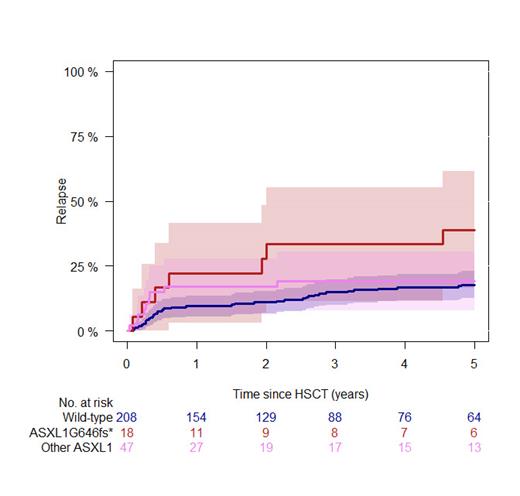Background
The discovery of prognostically informative mutations in patients with primary myelofibrosis (PMF) prompted the development of mutation-enhanced risk scores. Among these mutations, those in ASXL1 are invariably associated with adverse outcome, either as single variants or as part of a high-mutation-risk category (HMR) including SRSF2, EZH2, and IDH1/2. Furthermore, it was suggested that ASXL1 mutations show distinct outcomes in PMF and post polycythemia vera / essential thrombocythemia myelofibrosis (PPV/PET MF). Particularly, the ASXL1G646fs* variant was reported to have a strong adverse impact on survival, specifically in patients with PMF.
For patients undergoing curative treatment with hematopoietic cell transplantation (HCT), ASXL1 mutations were associated with increased risk for post-transplant mortality and therefore included in transplant-specific risk stratification. However, results on outcomes of different variants have not been reported so far.
Patients and Methods
We here report characteristics and outcomes of 273 patients with PMF (n=169, 62%) and PPV/PET MF (n=104; 38%) who underwent first HCT. Patients were homogenously treated with reduced-intensity conditioning using busulfan-fludarabine and anti-T-lymphocyte globulin for graft-versus-host disease prophylaxis. Patient samples were collected prior to start of conditioning and analyzed using next-generation sequencing. Primary endpoint was post-transplant overall survival, secondary endpoints were non-relapse mortality and incidence of relapse.
Results
The median age at the time of HCT was 59 years (range, 29-75). 57% of patients were male and 43% were female, 62% tested positive for cytomegalovirus (CMV). DIPSS at time of HCT was low (1%), intermediate-1 (22%), intermediate-2 (55%), and high (22%). Transfusion-dependency at time of HCT was present in 54% of patients, 50% received Ruxolitinib prior to HCT. Fibrosis grade 2 or higher was detected in 85% of patients. In terms of driver mutation genotype, 10% of patients were triple negative 63% of patients tested positive for JAK2, 22% for CALR, and 6% for MPL.
In the total cohort, 24% of patients had a detectable ASXL1 mutation (7% had ASXL1G646fs* and 3% ASXL1R634fs*). There was a significant difference in distribution of mutations according to type of MF, with 83% and 71% of patients with ASXL1G646fs* or ASXL1R634fs* having PMF, while 75% of patients with other ASXL1 mutations had PMF compared with 25% having PPV/PET MF (P=0.04) .
ASXL1G646fs* was associated with a tendency towards higher absolute leukocyte counts and lower platelet counts at time of HCT compared with wild-type or other ASXL1 mutations (P=0.10 and 0.07). DIPSS categories did not differ significantly between ASXL1G646fs*, other ASXL1 mutations and wild-type (P=0.66).
No difference in co-occurring driver mutations between the groups was detected (P=0.38). Notably, more patients with ASXL1G646fs* had co-occurring mutations in EZH2 (P=0.004) and RUNX1 (P=0.003).
In terms of outcomes, ASXL1 mutations showed worse overall survival (P=0.01), with no difference between ASXL1G646fs* and other ASXL1 mutations (P=0.51). 5-year survival was 54% for ASXL1G646fs* 53% for ASXL1 and 74% for the wild-type group. Poorer survival was seen in both PMF and PPV/PET MF (P=0.002 and P=0.03, respectively). Patients with ASXL1G646fs* showed significantly higher rates of early relapse 1 year after HCT, with incidence of 22% compared with 17% for other ASXL1 mutations and 10% for the wild-type group (P<0.001; Figure). Multivariable modelling (including donor type, leukocyte and platelet counts, Karnofsky performance status, and age) confirmed similar outcomes for the ASXL1 groups but higher risk for death compared with wild-type configuration, with hazard ratios of 1.50 for ASXL1G646fs* and 1.62 for other ASXL1 mutations. ASXL1G646fs* was associated with significantly higher risk for relapse (hazard ratio, 1.95).
Conclusion
ASXL1 mutations showed significantly inferior post-transplant outcomes in both PMF and PPV/PET MF. While the newly identified mutation ASXL1G646fs* was associated with worse outcomes (especially for post-transplant relapse), HCT seems to abrogate the recently suggested onset poorer outcomes for this mutation compared with other ASXL1 mutations.
Disclosures
Kroeger:Novartis, Neovii: Honoraria, Research Funding; Celgene/BMS: Honoraria, Research Funding; AOP Orphan Pharmaceutical, JAZZ, Takeda, Astellas: Honoraria; Riemser: Research Funding.


This feature is available to Subscribers Only
Sign In or Create an Account Close Modal